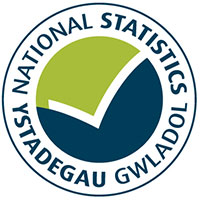Labour market data for UK countries and regions and also for local areas for July 2019 to June 2020.
This is not the latest release in the series: Labour market statistics (Annual Population Survey)
The data for this period covers a short part of the coronavirus (COVID-19) pandemic, and it will be difficult to determine the full impact that the pandemic has had on the labour market until more data becomes available. In the Key economic statistics report, we have included analysis on data sources that are giving more timely indications on how the pandemic is affecting the labour market in Wales.
Revision note
This headline has been revised due to a reweighting to the Labour Force Survey (LFS), on which the Annual Population Survey (APS) is based. This has impacted two periods of APS data: year ending March 2020, and year ending June 2020.
The coronavirus (COVID-19) pandemic meant that LFS interviews moved from being mainly face to face to telephone interviews earlier in the year. This led to a change in the types of households responding to the survey, and a potentially less representative sample in terms of housing tenure. The survey has therefore been reweighted so that the housing tenure distribution is the same as before the pandemic hit in March. This is explained in detail in an Office for National Statistics blog.
While the re-weighting has not changed the general trend of the data, it has slightly decreased the employment rate for Wales, and slightly increased the unemployment and economic inactivity rates.
Employment
The employment rate for people aged 16 to 64 in Wales was 73.8%, up 0.6 percentage points on the previous year. The UK rate was 75.8%, up 0.4 percentage points over the year.
Since 2001, the employment rate has increased by 6.6 percentage points in Wales and by 3.6 percentage points in the UK.
The highest estimated employment rates were in Monmouthshire (81.0%), Flintshire (80.2%) and Powys (78.1%).
The lowest estimated employment rates were in Merthyr Tydfil (68.8%), Swansea (69.1%) and Blaenau Gwent (69.8%).
Unemployment
The unemployment rate for people aged 16 and over in Wales was 3.7%, down 0.6 percentage points compared with the previous year. The UK rate was 3.9%, down 0.1 percentage points over the year.
Since 2001, the unemployment rate has fallen by 1.8 percentage points in Wales and by 1.1 percentage points in the UK.
The lowest estimated unemployment rates were in Newport (1.8%), Monmouthshire (2.4%) and Flintshire (2.5%).
The highest estimated unemployment rates were in Merthyr Tydfil (6.2%), Swansea (5.4%) and Isle of Anglesey (5.3%).
Youth unemployment
The youth unemployment rate in Wales was 11.3%, below the UK rate of 11.7%.
Since 2001, the youth unemployment rate fell 2.9 percentage points in Wales and by 0.1 percentage points in the UK.
Long term unemployment
24.3% of unemployed people in Wales had been unemployed for 12 months or more. This compares with 21.4% in the UK.
Economic inactivity (excluding students)
The economic inactivity rate for people aged 16 to 64 in Wales was 19.7%, down 0.1 percentage points compared with the previous year. The UK was 17.3%, down 0.1 percentage points over the year.
Since 2001, the economic inactivity rate fell by 6.7 percentage points in Wales and by 4.1 percentage points in the UK.
The lowest estimated economic inactivity rates were in Monmouthshire (13.1%), Cardiff (15.0%) and Flintshire (15.2%).
The highest estimated economic inactivity rates were in Blaenau Gwent (24.9%), Neath Port Talbot (23.3%) and Swansea (23.2%).
Data
Datasets and interactive tools
Contact
Vanessa Allis
Telephone: 0300 025 9019
Email: economic.stats@gov.wales
Rydym yn croesawu galwadau a gohebiaeth yn Gymraeg / We welcome calls and correspondence in Welsh.

